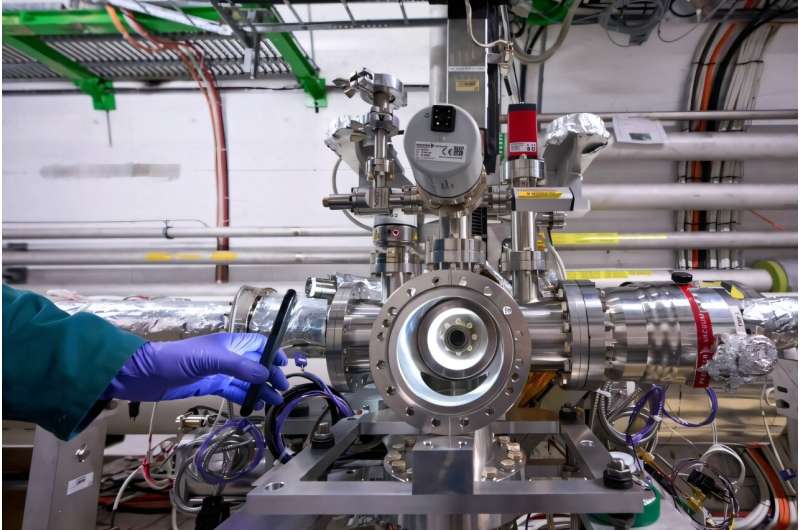Science
New Beam Monitor Enhances Operations at Large Hadron Collider

A new beam diagnostic instrument has been approved for continuous operation at the Large Hadron Collider (LHC), the world’s most powerful particle accelerator. Developed by the University of Liverpool‘s QUASAR Group, the device, known as the Beam Gas Curtain (BGC) monitor, is designed to measure the properties of high-energy particle beams without interference. This groundbreaking technology enables approximately 2,000 hours of operation each year.
The BGC monitor has been the result of a decade-long development process, led by Professor Carsten P. Welsch, Head of the QUASAR Group. He stated, “This is a tremendous achievement for our collaboration. Seeing a device that began as a concept explored by several generations of our Ph.D. students now operating at the heart of the LHC is truly inspiring.”
Innovative Technology at Work
The Beam Gas Curtain technique was recently detailed in a study published in Physical Review Research. This method involves creating an ultra-thin, supersonic sheet of neon gas that acts as a “curtain” interacting with the circulating proton or lead ion beam. By capturing the resulting faint flashes of fluorescence, researchers can gain precise insights into the beam’s size and quality throughout its acceleration cycle.
In contrast to existing instruments that require significant calibration time or interrupt experiments, the BGC continuously monitors beam profiles and emittance from the initial injection at 450 GeV up to the LHC’s peak energy of 6.8 TeV. This innovative approach not only enhances efficiency but also maintains the integrity of ongoing physics experiments.
Integration and Future Applications
Prior to its installation at CERN, the BGC was rigorously tested at the Cockcroft Institute. The results have surpassed expectations, delivering high-precision, non-invasive measurements for both proton and heavy-ion beams. The findings align closely with independent diagnostics used at the LHC, such as the Beam Synchrotron Radiation Telescope and emittance scans at the ATLAS and CMS experiments.
Dr. Hao Zhang, Deputy Group Leader of the QUASAR Group, expressed his enthusiasm: “Having our monitor now fully integrated into daily LHC operations is a real ‘wow’ moment. It is the culmination of years of development, from vacuum compatibility studies and optical design to software integration and on-site commissioning.”
With the BGC now permanently incorporated into the LHC’s beam instrumentation, its success is expected to influence similar systems at other major research facilities, including the European Spallation Source in Sweden and the Electron Ion Collider in the United States.
Professor Welsch highlighted the broader implications of this achievement, stating, “This accomplishment shows how university-based innovation can directly shape the tools that keep the world’s largest scientific instruments running. It is a very proud moment for Liverpool and for all the students and researchers who contributed to this remarkable journey.”
For further details, the full study is available in Physical Review Research authored by O. Sedlacek et al., titled “Full-cycle, noninvasive emittance monitoring with the beam gas curtain monitor at the LHC.”
-

 Health2 months ago
Health2 months agoNeurologist Warns Excessive Use of Supplements Can Harm Brain
-

 Health3 months ago
Health3 months agoFiona Phillips’ Husband Shares Heartfelt Update on Her Alzheimer’s Journey
-

 Science4 weeks ago
Science4 weeks agoBrian Cox Addresses Claims of Alien Probe in 3I/ATLAS Discovery
-

 Science4 weeks ago
Science4 weeks agoNASA Investigates Unusual Comet 3I/ATLAS; New Findings Emerge
-

 Science4 weeks ago
Science4 weeks agoScientists Examine 3I/ATLAS: Alien Artifact or Cosmic Oddity?
-

 Science3 weeks ago
Science3 weeks agoNASA Investigates Speedy Object 3I/ATLAS, Sparking Speculation
-

 Entertainment4 months ago
Entertainment4 months agoKerry Katona Discusses Future Baby Plans and Brian McFadden’s Wedding
-

 World2 months ago
World2 months agoCole Palmer’s Cryptic Message to Kobbie Mainoo Following Loan Talks
-

 Entertainment4 months ago
Entertainment4 months agoEmmerdale Faces Tension as Dylan and April’s Lives Hang in the Balance
-

 Science3 weeks ago
Science3 weeks agoNASA Scientists Explore Origins of 3I/ATLAS, a Fast-Moving Visitor
-

 Entertainment4 months ago
Entertainment4 months agoLove Island Star Toni Laite’s Mother Expresses Disappointment Over Coupling Decision
-

 Entertainment3 months ago
Entertainment3 months agoMajor Cast Changes at Coronation Street: Exits and Returns in 2025









